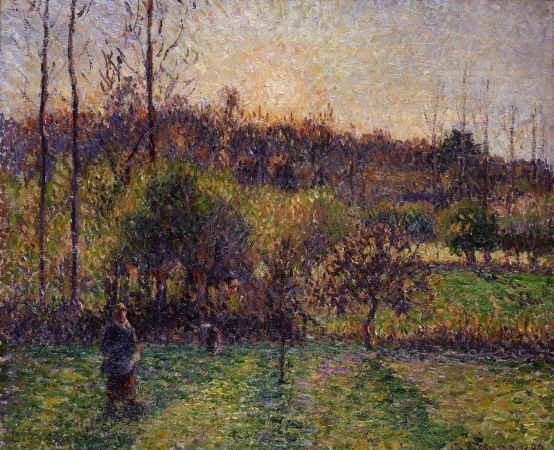PISSARRO, Sunrise at Éragny

Camille PISSARRO (1831-1903)
Sunrise at Éragny
1894
oil on canvas
38.3 x 46 cm
© MuMa Le Havre / Florian Kleinefenn
Sunrise at Éragny
1894
oil on canvas
38.3 x 46 cm
© MuMa Le Havre / Florian Kleinefenn
HD image
podcast
Pissarro's move to Éragny and subsequent adherence to Neo-Impressionist theories marked a turning point in his artwork. His paintings became genuine odes to agriculture and peasant life, with the monumental human figure at the fore. He composed his artworks in the studio after numerous preparatory studies, resulting in rigorously structured landscapes with powerful statis and intense luminosity. Paradoxically, Pissarro's Neo-Impressionism introduced a transitory element, a moment of the day: the countryside appears enveloped in mist, bathed in sunlight, or blanketed in white snow.
His Neo-Impressionist period only lasted four years, from 1884 to 1888. He pursued the divisionist style in the following years, but not in a systematic way. When he painted Sunrise at Éragny, the Neo-Impressionist influence could be seen in the vibrant and luminous brushwork. The time of day is clearly defined in the title of the artwork. The skimming light of the sun rising over the countryside structures the painting into areas of green alternating with areas of shadow in strong backlight. The rays of sunlight filter through the poplars and fruit trees, creating an extremely refined effect of perspective.
Two figures melt into the shadows of the apple trees in the meadow and only gradually become distinguishable once our eye grows accustomed to the light. Pissarro painted in this location until the end of his life, familiar with every inch of the meadow, the tall beech trees lining it, the apple trees in the orchard next to the house, the plain and the rooftops of Bazincourt. Here we are in the meadow that borders Pissarro's house in Éragny, outlines of female figures can be made out in the branches. The brushstrokes are thick and oily. The motif remains.
His Neo-Impressionist period only lasted four years, from 1884 to 1888. He pursued the divisionist style in the following years, but not in a systematic way. When he painted Sunrise at Éragny, the Neo-Impressionist influence could be seen in the vibrant and luminous brushwork. The time of day is clearly defined in the title of the artwork. The skimming light of the sun rising over the countryside structures the painting into areas of green alternating with areas of shadow in strong backlight. The rays of sunlight filter through the poplars and fruit trees, creating an extremely refined effect of perspective.
Two figures melt into the shadows of the apple trees in the meadow and only gradually become distinguishable once our eye grows accustomed to the light. Pissarro painted in this location until the end of his life, familiar with every inch of the meadow, the tall beech trees lining it, the apple trees in the orchard next to the house, the plain and the rooftops of Bazincourt. Here we are in the meadow that borders Pissarro's house in Éragny, outlines of female figures can be made out in the branches. The brushstrokes are thick and oily. The motif remains.
























